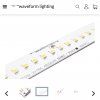cdgmoney250
Well-Known Member
Hey growers,
Took a bit of time off, but I’m looking go to get back in the saddle again.
With all the recent discussion lately about LEDs and spectrum (Far Red, Infrared, UV) and LED companies starting to jump on the bandwagon of adding monochromatic chips to their fixtures to enhance the spectrum, I’m wondering why companies aren’t pursuing broader Spectrum High CRI White Phosphor LED chips? Are any growers currently using high CRI chips (>90CRI) that could give their opinions or direct me towards a grow journal using them?
I am currently looking to make some propagation/mother lights using the best spectrums can find. Highest electrical efficiency/efficacy is not my main goal here, it is mostly hunting for the best most broad spectrum White Phosphor chips I can find, and delivering enough ppfd to stimulate the plants. I’ve looked through the Spectral Distribution Charts on the most common LED companies and haven’t been super impressed. The best I’ve seen from the standard lot really is the Bridgelux V10 Thrive Series and the Lumiled Luxeon 2835 CrispColor series. If anybody has any better suggestions for usual suspects please let me know.
I will likely be mixing 3000k and either 4000k or 5000k depending on the spectrum.
Took a bit of time off, but I’m looking go to get back in the saddle again.
With all the recent discussion lately about LEDs and spectrum (Far Red, Infrared, UV) and LED companies starting to jump on the bandwagon of adding monochromatic chips to their fixtures to enhance the spectrum, I’m wondering why companies aren’t pursuing broader Spectrum High CRI White Phosphor LED chips? Are any growers currently using high CRI chips (>90CRI) that could give their opinions or direct me towards a grow journal using them?
I am currently looking to make some propagation/mother lights using the best spectrums can find. Highest electrical efficiency/efficacy is not my main goal here, it is mostly hunting for the best most broad spectrum White Phosphor chips I can find, and delivering enough ppfd to stimulate the plants. I’ve looked through the Spectral Distribution Charts on the most common LED companies and haven’t been super impressed. The best I’ve seen from the standard lot really is the Bridgelux V10 Thrive Series and the Lumiled Luxeon 2835 CrispColor series. If anybody has any better suggestions for usual suspects please let me know.
I will likely be mixing 3000k and either 4000k or 5000k depending on the spectrum.
Last edited:




















